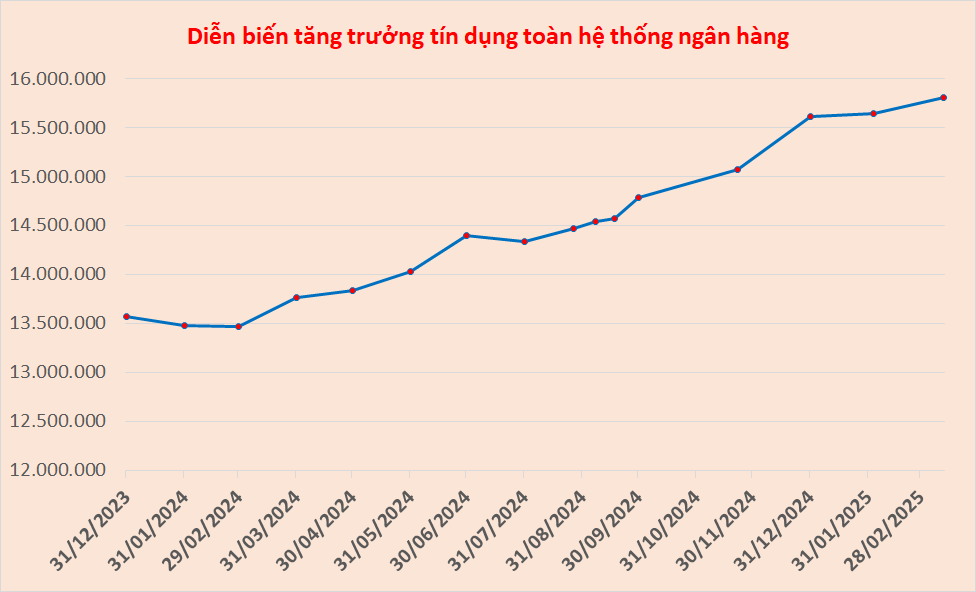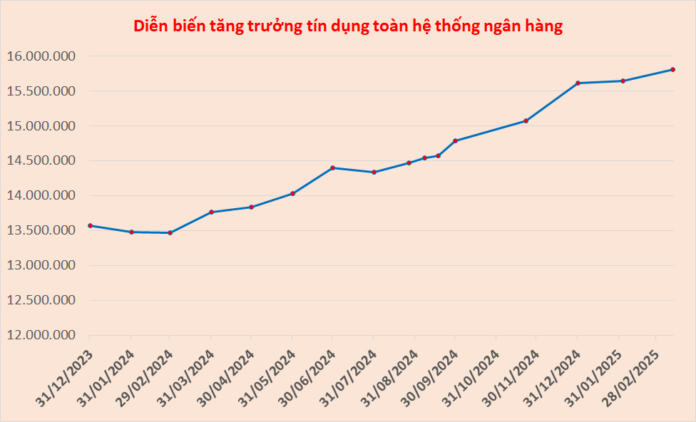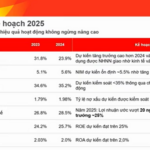According to the latest data shared by Deputy Governor of the State Bank of Vietnam, Pham Thanh Ha, at the Conference on Promoting Bank Credit held in Hai Phong, the credit of the entire banking system as of March 12 increased by 1.24% compared to the end of 2024 (in the same period in February 2024, it decreased by 0.74%).
“According to the norm, credit at the beginning of the year usually decreases, but at the beginning of 2025, credit growth showed signs of improvement compared to the same period last year,” said the Deputy Governor.
Previously, the data published by the State Bank showed that the total credit outstanding of the system at the end of 2024 reached VND 15,620 trillion and VND 15,650 trillion as of February 3 (right after the 2025 Lunar New Year). According to estimates by the State Bank, the scale of credit of the entire banking system as of March 12 reached VND 15,810 trillion, an increase of nearly VND 194 trillion compared to the end of 2024 and an increase of approximately VND 164 trillion since the Lunar New Year.

Source: Compiled from SBV-published data
In 2025, the State Bank set a credit growth target of 16%, equivalent to an increase of nearly VND 2.5 quadrillion, with room for further expansion if conditions permit. With this target in mind, the State Bank has implemented several solutions to boost credit growth from the beginning of the year.
Accordingly, the State Bank has assigned a total credit growth target of approximately 16% for 2025 to credit institutions, enabling them to proactively meet the capital needs of individuals, businesses, and the economy. In the first two months of 2025, the State Bank has issued ten documents directing credit institutions to vigorously implement solutions for credit growth and create favorable conditions for accessing bank credit.
Permanent Deputy Governor Dao Minh Tu said that the banking industry plans to inject about VND 2.5 quadrillion into the market, equivalent to a 16% credit growth rate in 2024. If the government’s economic growth target is 10%, then a 20% increase in credit, equivalent to more than VND 3-3.2 quadrillion, is expected.
In the context of global economic fluctuations, achieving the economic growth target of 8% and striving for a higher rate of 10% will be a challenging task for the banking sector. This is because, fundamentally, growth requires investment expansion, and investment expansion requires more resources, including financial capital. For many years, financial capital has mainly relied on bank credit.
Over the years, with its determined approach to monetary and credit policy management, the banking sector has been very proactive and reform-oriented. Banks have rapidly adopted technology in their credit operations, significantly reducing costs compared to the past. Banks have always played the role of a “midwife” for the economy in terms of capital provision, especially when the capital market and the corporate bond market have not developed as desired.
“Bank capital is supplementary to working capital and short-term capital. Banks themselves mobilize short-term capital but have to lend medium and long-term capital, filling the gap left by the capital market,” emphasized Deputy Governor Dao Minh Tu.
This year, banks have also set high credit growth targets. For instance, ACB aims to reach a customer lending target of VND 673,596 billion (up 16%). OCB plans to achieve a total market loan balance of VND 208,472 billion, an increase of 16%. VIB’s credit growth target for this year is 22%. BIDV’s Board of Directors also presented to its shareholders a 2025 business plan with a credit growth orientation of 15-16%. Vietcombank aims for a credit growth rate of 16.28%.
According to Mr. Phan Duc Tu, Chairman of the Board of BIDV, the state-owned commercial banks (SOCBs) have, from the beginning of the year, issued resolutions, decisions, and action programs to promptly implement the Government’s directions under Resolution 01 and the SBV’s instructions.
“The credit balance of the five state-owned commercial banks (including Agribank, Vietcombank, Vietinbank, MB, and BIDV) is currently at VND 7,726,000 billion, accounting for 49.5% of the total outstanding credit of the economy. If this year, following the Government’s and SBV’s direction, credit growth reaches 15-16%, we will inject millions of billions of VND into the economy. Specifically, the additional credit balance will be approximately VND 1,158,000-1,236,000 billion. Of this, BIDV alone will contribute an increase of VND 328,000 billion, aiming for a year-end credit balance of VND 2,400,000 billion,” said Mr. Tu at the Conference of the Government’s Standing Committee with state-owned enterprises on February 27.
“We have also implemented stimulus lending programs for consumption and individuals… This is one of the guarantees for maintaining the payment capacity of the economy and stimulating demand through increasing the total demand of the economy,” emphasized the Chairman of BIDV.
The Latest Credit Growth Figures: Unveiling the Banking System’s Performance
“The banking sector is off to a strong start this year, with credit growth outpacing that of the previous year. According to Vice Governor of the State Bank of Vietnam, Pham Thanh Ha, as of March 12, credit growth in the banking system had increased by 1.24% compared to the end of 2024, indicating a significant improvement.”
The Art of Provincial Mergers: Streamlining Administrative Boundaries
The government has instructed the Ministry of Home Affairs to take the lead in collaborating with relevant agencies and local authorities to promptly develop a proposal for the continued reorganization and streamlining of administrative units at the provincial, district, and communal levels. This initiative aims to enhance efficiency and effectiveness in governance. The proposal will be submitted to the Party Committee of the Government, ensuring both quality and timely implementation.





















